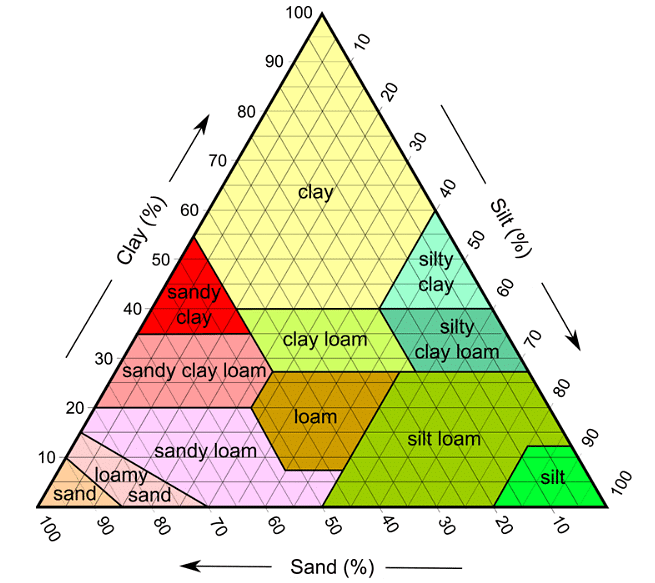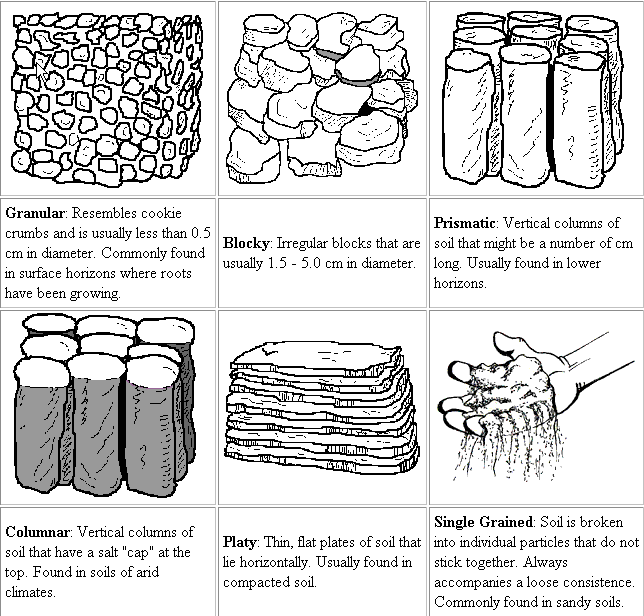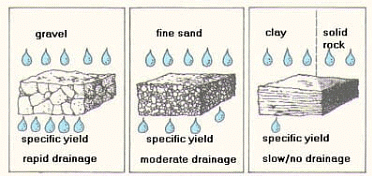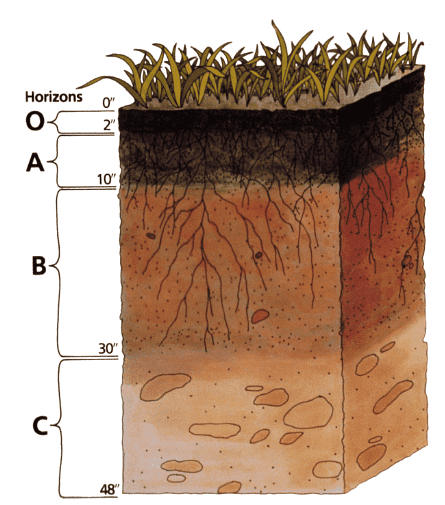Properties of Soil: Physical, Chemical & Biological - 1 | Agriculture Optional for UPSC PDF Download
Introduction
Soil represents the upper, weathered layer of the Earth's crust and is influenced by the presence of plants and animals. A soil profile, depicted in a vertical cross-section through this zone, typically exhibits several distinct layers or horizons that aid in identifying various soil types.
Soil comprises matter in solid, liquid, and gaseous states. The solid component consists of both organic and inorganic materials. The inorganic, or mineral, part of the soil is composed of particles originating from the parent material, which are the rocks that undergo weathering to form the soil. The organic component includes living and decomposed plant and animal substances like roots and worms, with the final decay product being humus, a black, shapeless organic material. Soil water is a diluted but complex chemical solution derived from direct precipitation, runoff, seepage, and groundwater. The soil atmosphere occupies the empty spaces within the soil when not filled with water.
Soil texture pertains to the size of solid particles making up the soil, ranging from gravel to clay. The proportions of these different sizes vary from one soil type to another and within different soil layers. Texture significantly influences the soil's water retention properties. Sandy soil contains large pore spaces, allowing rapid drainage, while clay soil has tiny pores that hinder proper drainage. In general, loam textures are considered optimal for plant growth.
Soil acidity is determined by the proportion of exchangeable hydrogen ions relative to other elements in the soil. The pH scale, a logarithmic scale ranging from 0 (extremely acidic) to 14 (highly alkaline), measures the degree of acidity. Few soils reach the extremes of this scale, with a pH value of approximately 6.5 typically seen as the most favorable for cereal crop growth.
Soil color can vary widely and provides insights into soil formation and composition. In recently formed soils, the color often mirrors that of the parent material, but in many cases, the soil's color differs from the underlying rock. Soil colors can span from white to black, mainly depending on the amount of humus present.
In cool, humid regions, soils usually contain high humus content, appearing black or dark brown, while in arid or semi-arid areas, soils have limited humus content and tend to be light brown or grey. Reddish soil colors indicate the presence of ferric compounds, especially oxides and hydroxides, typically suggesting well-drained soil. However, in some instances, the red color may originate from red-hued parent materials.
Physical Properties of soil
It depends upon the amount, size, shape, arrangement, and mineral composition of soil particles. It also depends on the organic matter content and pore spaces.
Soil Texture
Soil texture describes the ratio in which soil particles separate to form the mineral component of the soil. These separations are categorized as sand, clay, and silt. Sand and silt are not particularly significant for soil, as they do not contribute significantly to the soil's capacity to retain water or nutrients. In contrast, clay plays a crucial role in soil texture due to its small particle size and the extensive surface area it provides per unit mass, facilitating the storage of ions and water.
Soil texture is a measure of the coarseness or fineness of the mineral content in the soil and is determined by the proportions of sand, silt, and clay particles. When all three are present in roughly equal proportions, the soil is referred to as loam. Soil texture influences various aspects of soil quality, including its ability to retain water, hold nutrients, fix nutrients, facilitate drainage, affect compressibility, and enhance aeration.
- Particle Size Definitions:
- Clay: Particle size with diameters less than 0.002 millimeters.
- Silt: Particle size ranging from 0.002 millimeters to 0.05 millimeters.
- Sand: Particle size varying from 0.05 to 2 millimeters.
Particles larger than 2 millimeters are considered pebbles, gravel, or rock fragments and are not technically considered soil particles.
Loamy Soil: Loamy soil is characterized by the absence of dominance among the three soil components (sand, silt, clay). Specifically, loamy soil typically consists of approximately 40% sand, 40% silt, and 20% clay.
Soil Structure
Soil structure refers to the organization of soil particles into specific configurations, such as plate-like, block-like, or prism-like structures, among others.
Soil structure is the result of how sand, silt, and clay particles are naturally grouped together, and it is influenced by organic matter (including decomposed plants and animals) as well as soil-dwelling organisms like earthworms and bacteria.
Various factors, including clays, organic matter, and substances produced by soil organisms, work together to create aggregates that bind soil particles into these structural patterns. Soil structure plays a crucial role in supporting plant growth, governing the movement of air and water, shaping root development, and influencing nutrient availability.
High-quality soils are typically crumbly and feature fine aggregates, allowing the soil to easily break apart when squeezed. In contrast, poor soil structure is characterized by coarse, compacted clods or a lack of structure altogether.
Specific Soil Structure Characteristics:
- Permeability: Permeability pertains to the ease with which liquids and gases can pass through rocks or layers of soil. It is determined by the size, shape, and arrangement of soil particles. Sandy soils typically exhibit high permeability, while clayey soils tend to have low permeability.
- Porosity: Porosity signifies the amount of water that can be retained within the soil. It is expressed as the ratio of the volume of voids or pores to the total volume of the material.

There are 5 basic types of structural units:
- Platy: Plate-like aggregates that form in parallel layers, resembling the pages of a book. This structure can impede the movement of air, water, and roots. It is commonly found in an E horizon and is less frequently observed in other horizons.
- Blocky: There are two variations – angular blocky and subangular blocky. These structures are typically present in the B horizon. Angular blocky structures have cube-like shapes with sharp corners, while subangular blocky structures have rounded corners.
- Prismatic: These units have a vertical axis longer than the horizontal axis. When the top is flat, they are referred to as prismatic, and when the top is rounded, they are called columnar.
- Granular: Granular structures consist of round, porous, and spheroidal peds. This is typically the structure found in A horizons.
- Structureless: This category includes soil with no discernible aggregation or structural units. It can manifest as single-grain (sand) or massive, appearing as a solid, unaggregated mass.

Soil Colour
Soil color, whether it appears as brown, yellow, or red, is primarily influenced by the presence of oxidized or ferric iron compounds. Darker soil colors are indicative of a higher organic content, as they absorb more heat due to their darker hue.
Soils that contain ample humus are often dark because decomposed organic matter tends to be black or brown. Soils rich in humus are typically very fertile, which is why dark brown or black soils are often referred to as "rich."
The presence of iron is typically denoted by red or yellow soil colors.
Soil Color Description: Soil color is characterized by three key parameters: hue, value, and chroma. Hue signifies the dominant wavelength or color of light, value indicates the lightness or darkness of the color, and chroma represents the relative purity or intensity of the color.
To assess soil color based on these parameters, it can be quickly determined by comparing a soil sample with a standardized set of color chips contained in a notebook known as Munsell Soil Color Charts. In these charts, the top right corner corresponds to the hue, the vertical axis represents the value, and the horizontal axis denotes the chroma.
Soil permeability
Soil permeability is a broad term that refers to the soil's capacity to allow the passage of water. Understanding the water dynamics and balance within the soil is crucial for effective irrigation management. Permeability is influenced in part by the soil's texture, where sandy soils exhibit higher permeability compared to clay soils, and it can be modified through soil management practices.
- In most cases, porous rocks are permeable, with the exception of clay, which has such tiny pore spaces that they are often sealed off by groundwater due to surface tension. Another exception is granite, which is non-porous but can still be permeable. Granite is a crystalline rock, thus lacking pores, and its individual crystals absorb minimal to no water. However, the rock may contain numerous joints and cracks through which water can flow, making it permeable.
- Soils with a high organic content also tend to have greater porosity, contributing to their permeability.

Soil Horizon
The soil is vertically divided into distinct horizons, organized from the top down:
- A-Horizon (Topsoil): This uppermost layer of soil, often referred to as topsoil, is rich in humus and minerals. It retains the majority of the water compared to other layers. The A-horizon is composed of a mixture of sand, silt, and clay and provides a habitat for various living organisms like snakes and earthworms.
- B-Horizon: Situated just beneath the A-horizon, the B-horizon is slightly richer in humus and retains moisture. It contains a blend of silt, clay, weathered rocks, and some essential nutrients. This layer typically holds a higher mineral content compared to the top layer.
- C-Horizon: The C-horizon is composed of small rock fragments that have broken down due to weathering processes.
- Bedrock: At the base of the soil profile lies the bedrock layer, which consists of solid, unweathered rock formations.

|
52 videos|224 docs
|
FAQs on Properties of Soil: Physical, Chemical & Biological - 1 - Agriculture Optional for UPSC
| 1. What are the physical properties of soil? |  |
| 2. How does soil texture affect plant growth? |  |
| 3. What is soil structure and why is it important? |  |
| 4. How does soil color indicate its properties? |  |
| 5. How does soil moisture content affect soil fertility? |  |
















